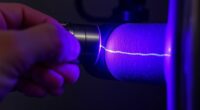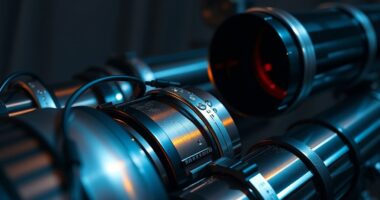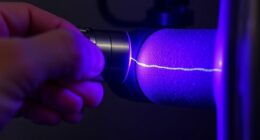If you want to improve your astrophotography with refractor telescopes, choosing the right field flattener makes a huge difference. I recommend models with high-quality, multi-coated optics that correct field curvature and minimize distortions across full-frame sensors. Compatibility and durable build are key, along with features like built-in flatteners and focal reducers. If you keep these factors in mind, you’ll get sharper, more accurate images. To explore the top options and what suits your setup best, keep exploring further.
Key Takeaways
- High-quality field flatteners correct field curvature and distortions, delivering sharp, flat images across full-frame sensors.
- Compatibility with various refractor telescopes (f/4 to f/8) and camera types ensures versatile astrophotography setups.
- Optical coatings and advanced glass elements reduce aberrations, glare, and ghosting for clearer celestial images.
- Built-in features like filters, rotators, and precise back focus support ease of use and optimal image focus.
- Durable, lightweight construction ensures reliable performance and easy integration in different astrophotography environments.
Explore Scientific Field Flattener for Refractor Telescopes
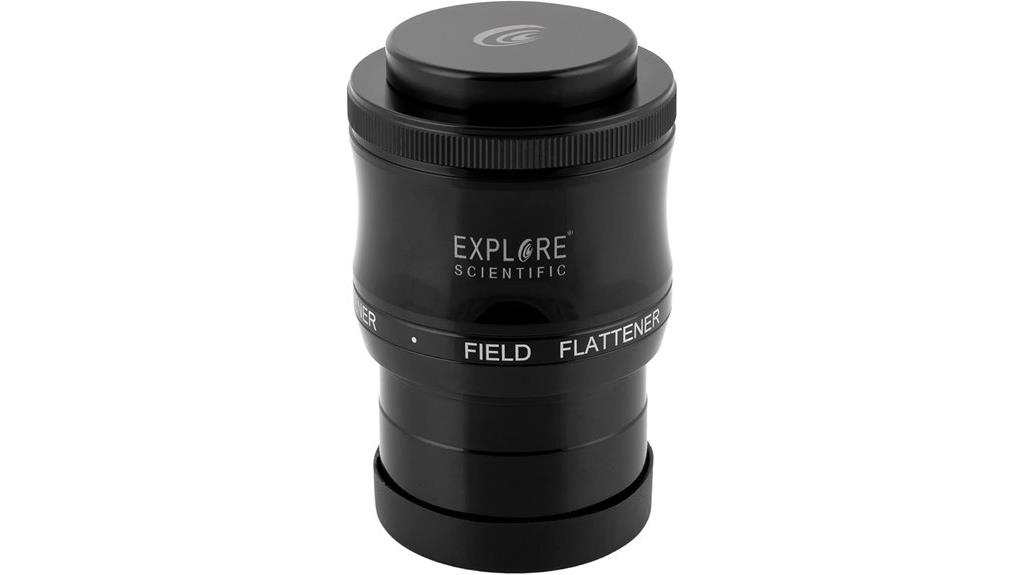
If you’re serious about astrophotography with refractor telescopes, the Explore Scientific Field Flattener is an excellent choice because it guarantees sharp, round stars across the entire image field. Designed for focal ratios between f/5 and f/7, it effectively minimizes star distortion caused by field curvature. I’ve used it with telescopes like the SVBony 102mm, and it consistently delivers flat, high-contrast images. The fully multi-coated optics maximize light transmission, making planets, nebulae, and star clusters pop with detail. Its durable build and straightforward setup, including a T-ring thread, make it a reliable tool for achieving distortion-free, professional-quality astrophotos.
Best For: astrophotographers using refractor telescopes with focal ratios between f/5 and f/7 seeking sharp, distortion-free images across their entire sensor.
Pros:
- Effectively minimizes star distortion caused by field curvature, ensuring round stars across the entire image field
- Fully multi-coated optics maximize light transmission for high-contrast, detailed images
- Durable construction with a straightforward setup, including a T-ring thread, for reliable use
Cons:
- Designed specifically for f/5 to f/7 systems, limiting compatibility with other focal ratios
- Requires precise 55mm (+/- 2mm) spacing between the flattener and camera sensor, which may need adjustments
- Slightly bulky at 2 x 2 x 4 inches and weighing around 4 pounds, potentially affecting portability
SVBONY SV503 Refractor Telescope for Astrophotography
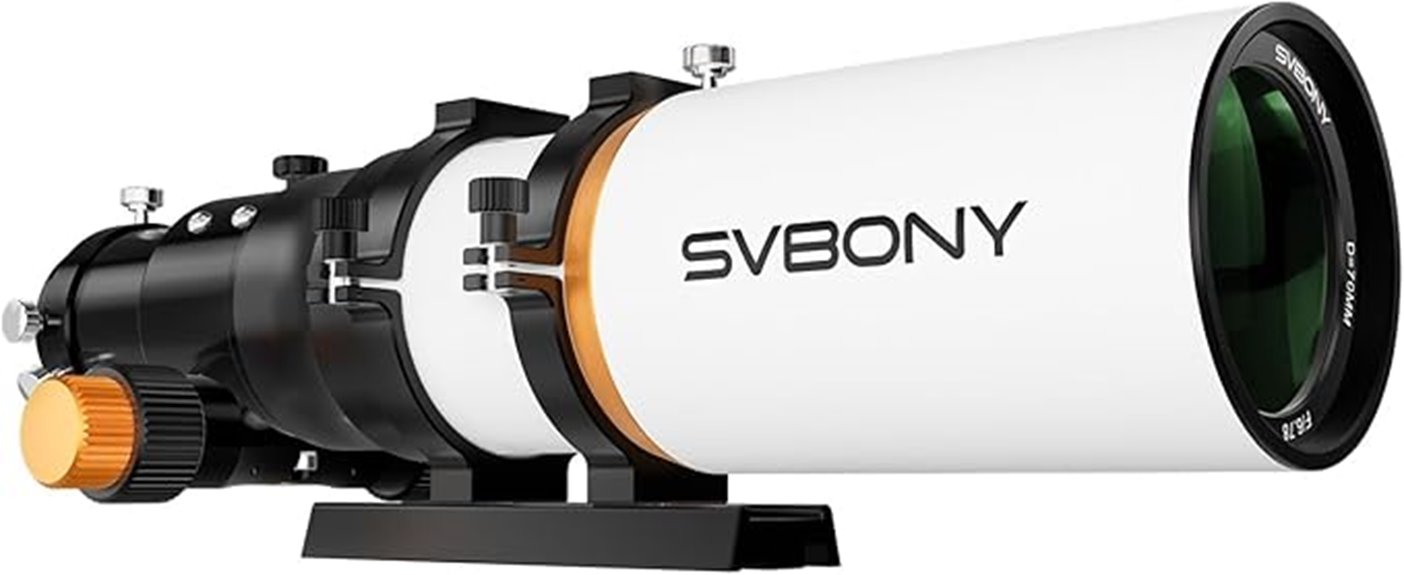
The SVBONY SV503 Refractor Telescope is an excellent choice for astrophotographers seeking sharp, distortion-free images, thanks to its built-in field flattener and flat-field optical design. Its 70mm aperture and F/6.78 focal ratio make it compact yet capable of capturing detailed celestial objects. The ED glass minimizes chromatic aberration, producing true-to-life colors. The dual-speed focuser allows precise adjustments, while the sturdy aluminum construction guarantees stability during imaging sessions. With high customer ratings and versatile compatibility, the SV503 delivers reliable, high-quality images. It’s perfect for amateur astronomers wanting a durable, portable refractor that excels in astrophotography.
Best For: amateur astrophotographers and stargazing enthusiasts seeking a compact, high-quality refractor telescope with excellent optical performance and portability.
Pros:
- Equipped with ED glass to minimize chromatic aberration and produce true-to-life colors
- Flat-field design with built-in field flattener for wide, distortion-free views of celestial objects
- Durable aluminum CNC construction ensures stability and longevity during imaging sessions
Cons:
- Limited aperture size of 70mm may restrict deep-sky object detail compared to larger telescopes
- Slightly heavier weight (5.92 pounds) may be less ideal for ultra-portable setups
- May require additional accessories (e.g., camera adapters) for complete astrophotography setups
SVBONY SV193 Focal Reducer 2 Inch 0.8X Telescope Accessory
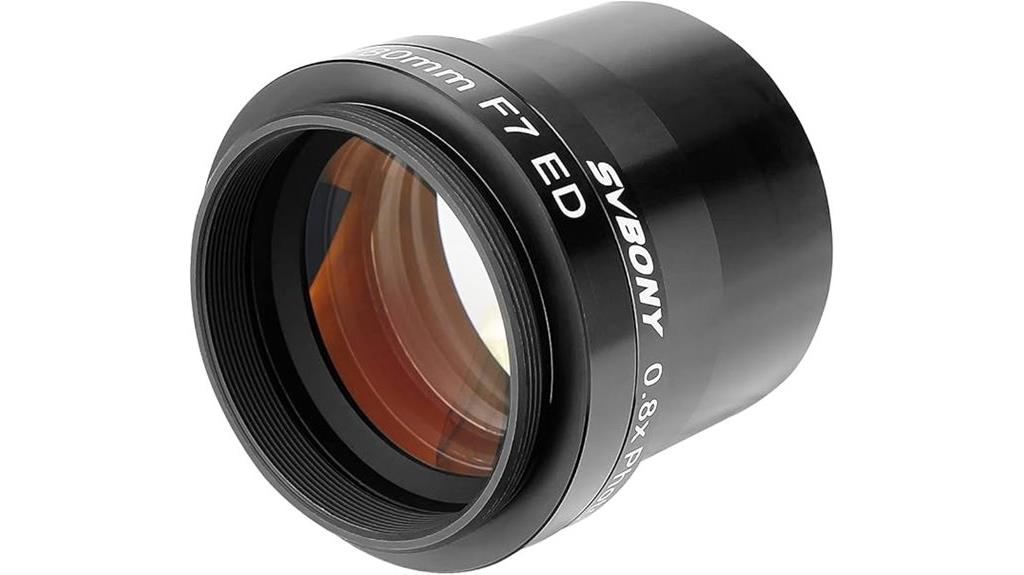
Designed specifically for astrophotographers seeking sharper edge-to-edge images, the SVBONY SV193 Focal Reducer 2 Inch 0.8X is an essential accessory for refractor telescopes. Its 0.8x reduction factor minimizes star distortion at the edges, delivering crisp, clear celestial images. The device features a standard 2-inch front socket for easy connection to your main lens and an M48x0.75 threaded back end compatible with full-frame cameras and filters. It also includes a 2-inch filter thread, allowing you to add light pollution or other filters to improve image quality under various sky conditions. This focal reducer shortens exposure times, making astrophotography faster and more efficient.
Best For: astrophotographers using refractor telescopes who want sharper edge-to-edge images and faster exposure times.
Pros:
- Reduces star distortion at edges for crisp, clear images
- Compatible with full-frame cameras and supports 2-inch filters
- Shortens exposure times, increasing imaging efficiency
Cons:
- Designed primarily for SV503 80mm F7 ED telescopes, limiting versatility with other models
- Requires proper threading and connection setup, which may be challenging for beginners
- May introduce some optical aberrations if not properly aligned or used with incompatible equipment
HOTECH SCA 2 Inch Field Flattener for Refractor Telescopes

For astrophotographers seeking sharp, distortion-free images across the entire field, the HOTECH SCA 2 Inch Field Flattener is an excellent choice. Designed for refractor telescopes, it features a fully multi-coated two-element lens that maximizes light transmission and minimizes aberrations. Compatible with f/5 to f/8 refractors, it delivers bright, detailed images from edge to edge. The built-in 2” filter thread and T-ring compatibility make it easy to attach all 35mm cameras. Its center-loading T-adapter and compression ring ensure precise alignment, resulting in consistent, high-quality astrophotos. Overall, it’s a reliable tool for capturing crisp, flat-field images without distortion.
Best For: astrophotographers using refractor telescopes (f/5 to f/8) seeking sharp, flat-field images with minimal aberration.
Pros:
- Fully multi-coated two-element lens maximizes light transmission and reduces aberrations.
- Compatible with all 35mm cameras thanks to built-in filter and T-ring threads.
- Ensures flat field correction, producing sharp images across the entire field with minimal distortion.
Cons:
- Price may vary; no specific cost information provided.
- Requires proper alignment and installation to achieve optimal results.
- Compatibility limited to refractor telescopes within f/5 to f/8 range, not suitable for other telescope types.
SVBONY SV209 Field Flattener, 0.8X Focal Reducer for Telescopes
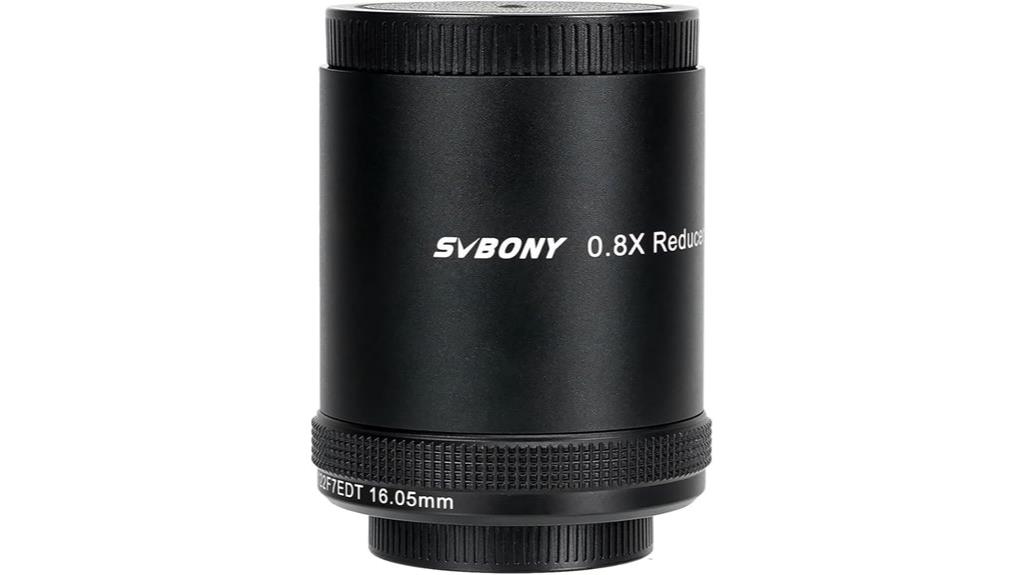
If you’re serious about capturing sharp, wide-field astrophotos, the SVBONY SV209 Field Flattener is an excellent choice, especially for SV550 122mm f/7 APO refractors. This 0.8X focal reducer converts your 854mm focal length (f/7) into a faster 683.2mm (f/5.6), broadening your field of view. It effectively corrects field curvature, ensuring sharp stars across the entire frame. Compatible with DSLR and CCD cameras via a 63×1 thread, it’s easy to install and enhances image quality. Keep in mind, precise backspacing is vital for an optimal focus and sharpness. Overall, it’s a valuable tool for astrophotographers seeking flat, high-quality images.
Best For: astrophotographers and astronomy enthusiasts using SV550 122mm f/7 APO refractors who want to achieve sharp, wide-field images with corrected field curvature.
Pros:
- Effectively reduces focal length from 854mm to 683.2mm, enabling wider field imaging
- Corrects field curvature for sharp stars across the entire frame
- Compatible with DSLR and CCD cameras with secure 63×1 thread connection
Cons:
- Precise backspacing is critical; incorrect extension tube setup can affect focusing and image quality
- Some users report difficulties with focusing or backfocus adjustments
- Variations in extension tube measurements may require careful setup to optimize performance
SVBONY SV550 Telescope Bundle for Deep Sky Astrophotography
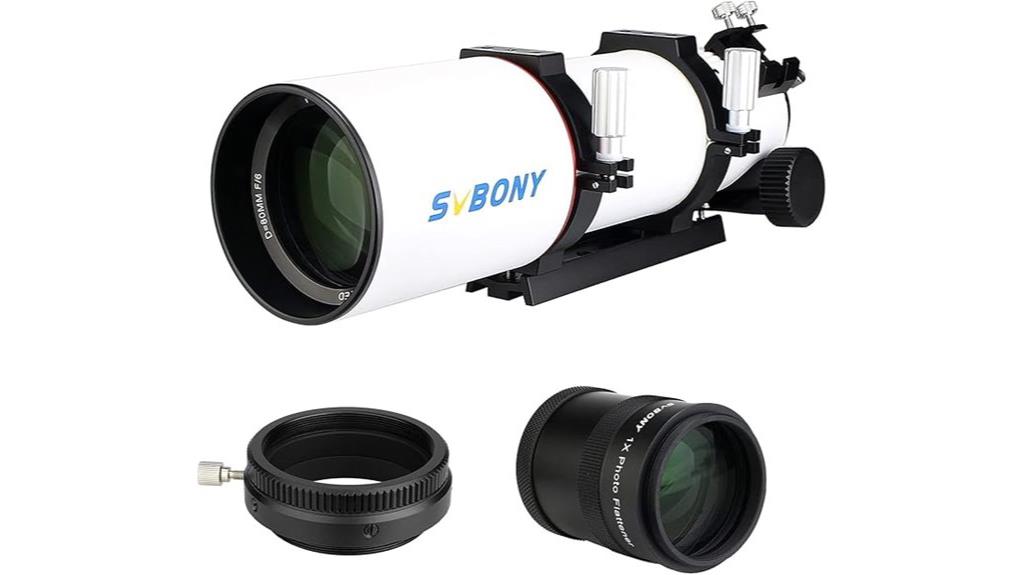
The SVBONY SV550 Telescope Bundle stands out as an excellent choice for amateur astronomers aiming to capture stunning deep-sky images. Its air-spaced triple optical design with APO triplet optics and low-dispersion ED glass virtually eliminates chromatic aberration, delivering bright, high-contrast images perfect for galaxy imaging. The included SV209 field flattener reduces fringe field curvature, ensuring sharpness across the entire view. With a built-in 2-inch filter thread and a 360-degree rotator, setup and framing are simplified, while stability is enhanced. Overall, this bundle offers a portable, high-quality solution tailored for deep sky astrophotography enthusiasts.
Best For: amateur astronomers and astrophotographers seeking a portable, high-quality telescope for deep sky imaging with minimal chromatic aberration.
Pros:
- Advanced optical design with APO triplet and low-dispersion ED glass for clear, high-contrast images
- Built-in 2-inch filter thread and field flattener for versatile and sharp astrophotography
- Includes rotator and accessories for precise framing and stable imaging sessions
Cons:
- May require additional mounts or accessories for complete astrophotography setups
- Heavier or bulkier than entry-level telescopes, which could affect portability for some users
- Higher price point compared to basic telescopic options
SVBONY SV220 Dual-Band Nebula Filter with SV503 70mm Refractor Telescope
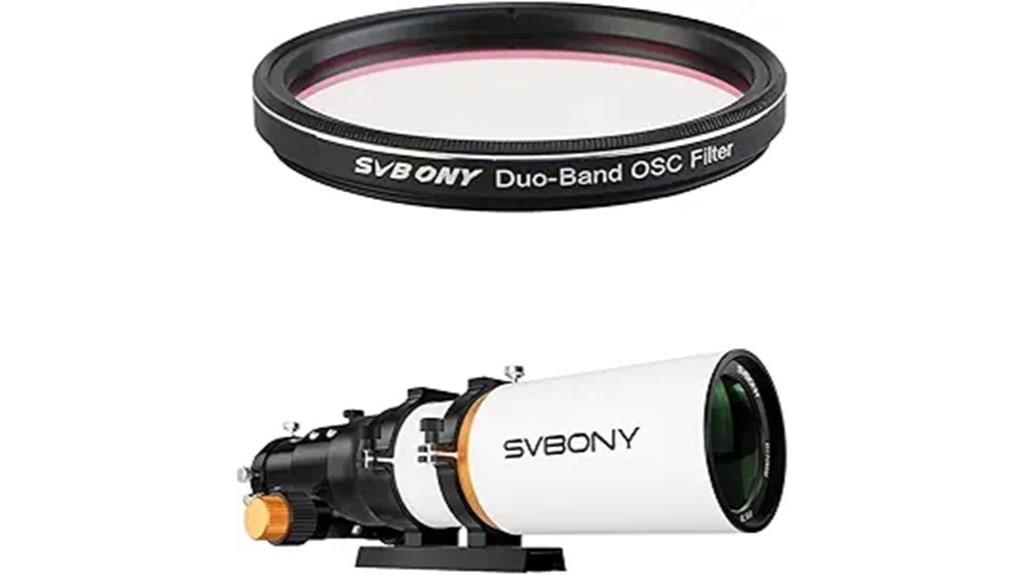
Astrophotographers and visual observers seeking sharp, distortion-free images will find the SVBONY SV220 Dual-Band Nebula Filter paired with the SV503 70mm refractor telescope an excellent choice. This combo enhances imaging of emission and planetary nebulae, as well as supernova remnants, by reducing light pollution from moonlight and streetlights. The SV503’s built-in field flattener and extra-low dispersion glass deliver wide, flat views with minimal chromatic aberration, ensuring true-to-life colors. The filter boosts contrast and detail without brightening objects artificially, making faint nebulae stand out clearly against the sky. It’s perfect for deep-sky imaging in challenging light conditions.
Best For: amateur and professional astrophotographers or visual observers seeking high-contrast, distortion-free images of deep-sky objects with minimal light pollution interference.
Pros:
- Enhances contrast and detail of emission and planetary nebulae, supernova remnants
- Built-in field flattener and extra-low dispersion glass provide wide, flat, true-to-life images with minimal chromatic aberration
- Effectively reduces light pollution from moonlight and streetlights, suitable for challenging lighting conditions
Cons:
- Designed specifically for the SV503 70mm refractor telescope, limiting compatibility with other models
- Available starting from May 10, 2025, so not currently in stock for immediate purchase
- May require additional accessories or adapters for certain setups or advanced imaging needs
SVBONY Focal Reducer for SV503 102mm ED Telescope
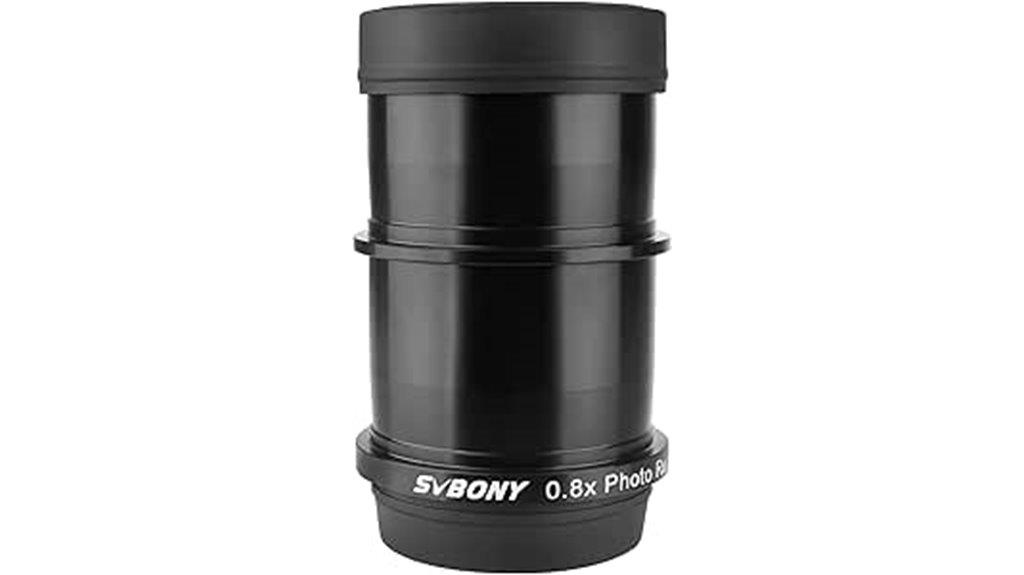
For those seeking sharper, wider-field images with their SV503 102mm ED refractor telescope, the SVBONY Focal Reducer is an excellent choice. It offers 0.8x focal reduction and field flattening, making it perfect for full-frame astrophotography. This reducer enhances celestial images by providing broader sky views, finer star points, and reduced focus issues, which improve the signal-to-noise ratio. Its durable, lightweight aluminum body features multi-coated optics for high performance, and it connects easily via standard 2-inch sockets and threaded back ends. Rated 4.6 out of 5 stars, it’s a reliable, versatile addition for serious astrophotographers.
Best For: serious astrophotographers seeking high-quality, full-frame images with wider sky views using their SV503 102mm ED refractor telescope.
Pros:
- Provides 0.8x focal reduction and field flattening for enhanced astrophotography
- High-quality multi-coated optics ensure clear, sharp images with minimal distortion
- Lightweight durable aluminum construction makes it easy to handle and install
Cons:
- May require additional adapters for compatibility with some camera models
- Slightly more expensive compared to basic focal reducers without field flattening features
- Requires careful handling to avoid scratches or damage to optical coatings
SVBONY SV260 2 Telescope Filter with SV503 Refractor Telescope
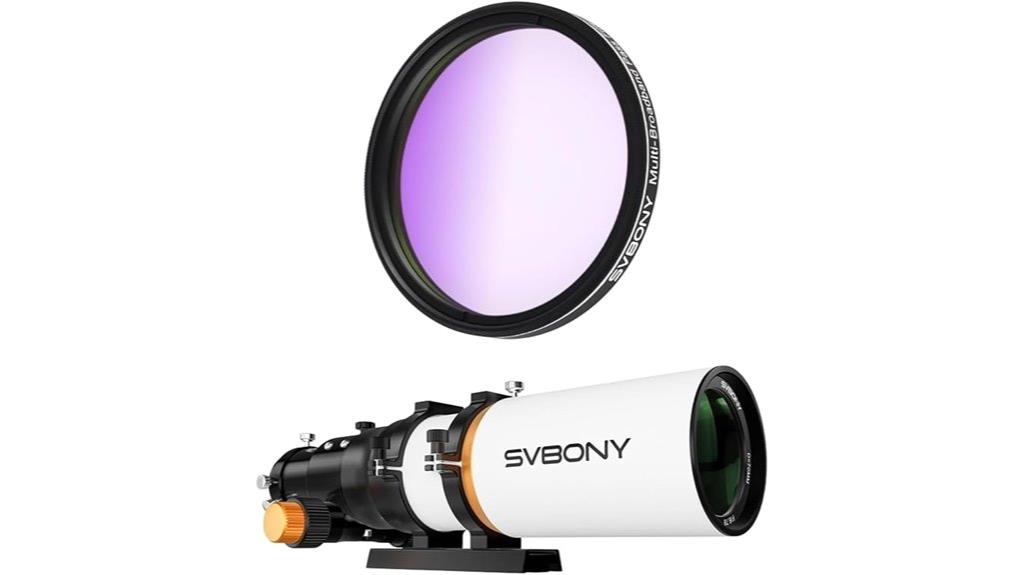
If you’re aiming to capture vibrant, detailed images of celestial objects in light-polluted areas, the SVBONY SV260 2 Telescope Filter with the SV503 Refractor Telescope is an excellent choice. This 5-bandpass broadband filter blocks 6 levels of light pollution while maintaining over 90% peak transmittance, enhancing starfield and deep-sky photography. The filter restores true colors of celestial bodies, providing richer hues and better detail. Paired with the SV503 refractor’s flat-field design and bright 70mm aperture, it delivers sharp, wide-field images with minimal distortion. This combo is perfect for astrophotographers seeking clear, colorful views despite urban light pollution.
Best For: amateur astrophotographers and stargazing enthusiasts seeking to capture vibrant, detailed images of celestial objects in light-polluted environments.
Pros:
- High transmittance (>90%) effectively maximizes light collection and preserves true colors of celestial objects
- Advanced 5-bandpass broadband filter efficiently blocks multiple levels of artificial light pollution for clearer images
- Flat-field design with built-in field flattener provides wide, distortion-free images with minimal edge blur
Cons:
- May require compatible mounting accessories for optimal integration with different telescopes
- Performance can be limited in extremely light-polluted urban areas beyond its designed 6-level light pollution blocking capability
- Specific to the SV503 refractor telescope; compatibility with other telescope models may vary
SVBONY SV48P 90mm Refractor Telescope for Beginners
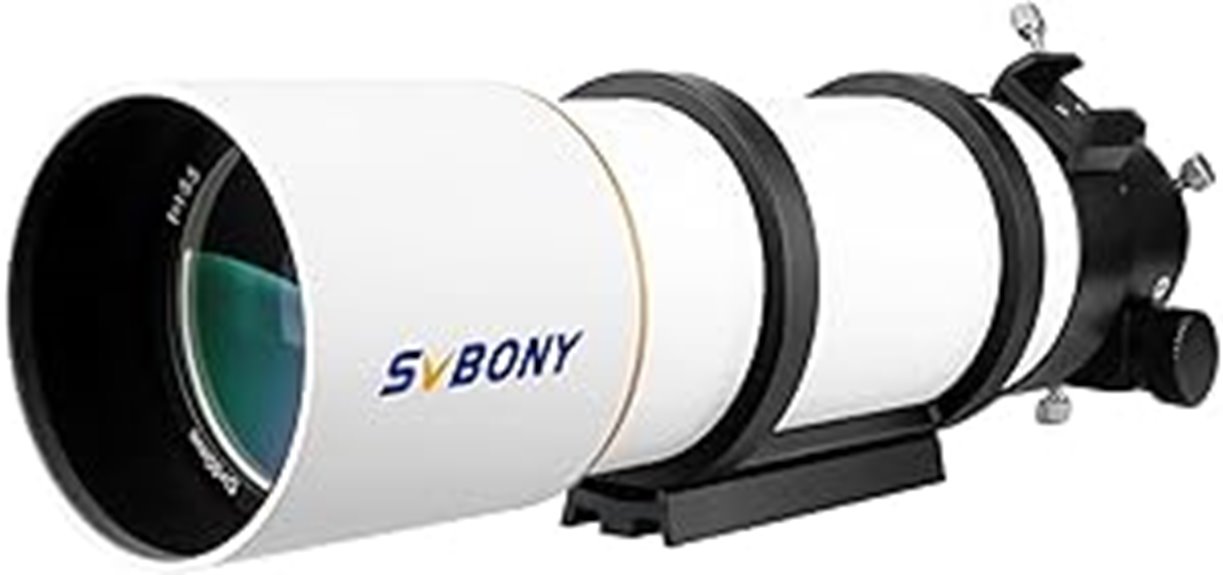
Looking for a beginner-friendly telescope that delivers sharp, clear images across the entire field of view? The SVBONY SV48P 90mm Refractor Telescope is an excellent choice. Its 90mm aperture and 500mm focal length gather plenty of light, ideal for lunar and deep-sky viewing. The fully multilayer green-coated lens minimizes false color and maximizes clarity, while the 2-inch rotatable focuser allows precise adjustments. Weighing just 6.6 pounds, it’s portable and easy to set up. Plus, the full rotation makes framing objects straightforward, making it perfect for newcomers enthusiastic to explore the night sky and capture stunning images.
Best For: beginners and amateur astronomers seeking a portable, easy-to-use telescope for lunar, planetary, and deep-sky observations and astrophotography.
Pros:
- High-quality 90mm aperture and 500mm focal length for bright, wide-field views
- Fully multilayer green-coated lens minimizes false color and enhances clarity
- 2-inch rotatable focuser allows precise, smooth adjustments and flexible viewing angles
Cons:
- Slightly heavier than smaller models at 6.6 pounds, which may impact portability for some users
- Suitable mainly for beginner and casual use; advanced astronomers may seek higher magnification options
- Limited to visual observation and beginner astrophotography; not designed for heavy-duty astrophotography projects
Askar 60F Flat-Field Telescope
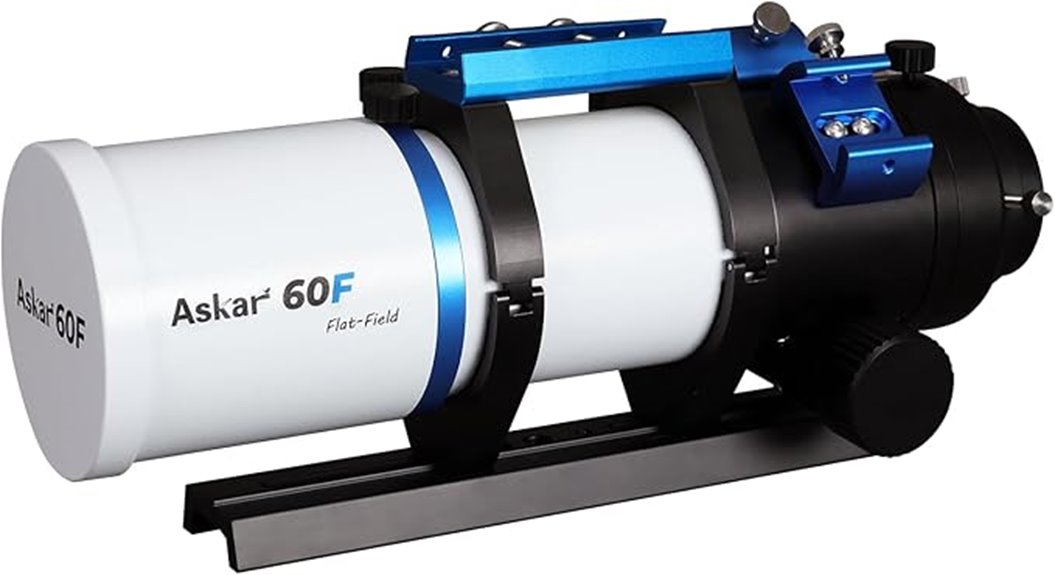
The Askar 60F Flat-Field Telescope stands out as an excellent choice for astrophotographers seeking sharp, edge-to-edge images with minimal chromatic aberration. Its 60mm aperture and 408mm focal length, combined with a quadruplet APO lens featuring ED glass, effectively reduce chromatic aberration and deliver high image quality. The built-in field flattener simplifies astrophotography by eliminating the need for additional flat-field accessories. With support for full-frame imaging, it ensures detailed star points across the entire field. Compact and lightweight at just 9 pounds, it’s ideal for portable setups, making both visual and photographic astrophotography more accessible and efficient.
Best For: astrophotographers and amateur astronomers seeking high-quality, portable, flat-field images with minimal chromatic aberration for deep sky imaging and visual observation.
Pros:
- Supports full-frame imaging for detailed star points across the entire field
- Built-in field flattener simplifies astrophotography setup and reduces additional accessories needed
- Compact and lightweight design enhances portability and ease of use
Cons:
- Limited aperture size may not be suitable for extremely deep-sky objects requiring larger telescopes
- May require additional accessories or adapters for specialized camera setups
- As a specialized astrophotography telescope, it might have a steeper learning curve for beginners
SVBONY SV503 Refractor Telescope with Built-in Field Flattener and SV305C Telescope Camera
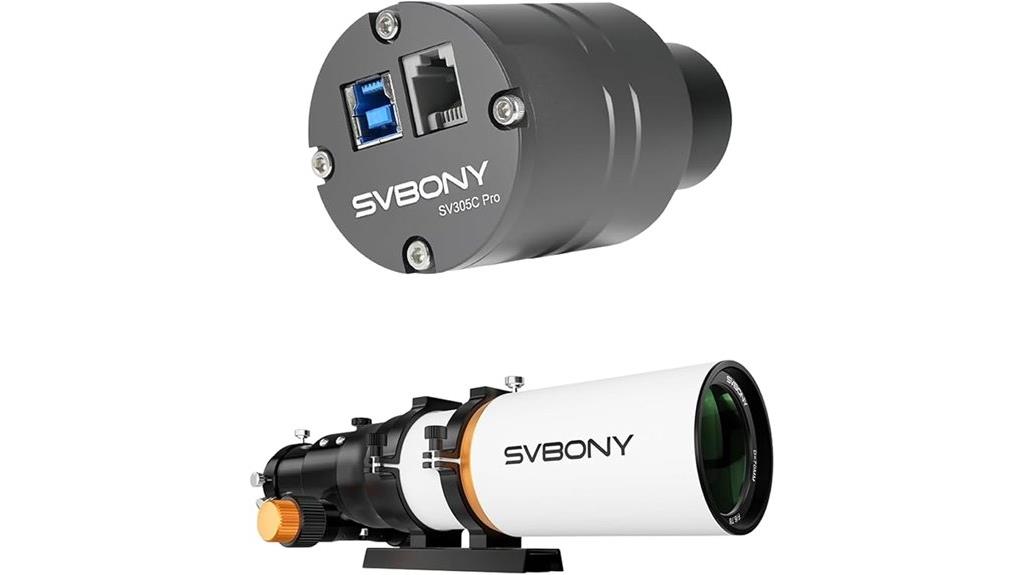
For amateur astronomers seeking sharp, distortion-free images across the entire field of view, the SVBONY SV503 Refractor Telescope with its built-in field flattener is an excellent choice. Its 70mm aperture and F/6.78 focal ratio produce bright, detailed images of galaxies, nebulae, and star clusters. The flat-field design minimizes chromatic aberration, and ED glass enhances clarity. Paired with the SV305C camera, it captures high-resolution, low-noise planetary images with remarkable detail. This integrated setup offers ease of use and high-quality results, making it ideal for both visual observation and astrophotography, especially for those wanting consistently sharp, true-to-color images.
Best For: amateur astronomers and astrophotographers seeking high-quality, distortion-free images of planets, galaxies, and nebulae with ease of use.
Pros:
- Combines advanced optical design with built-in field flattener for wide, flat views free of distortion
- Paired with a high-sensitivity, low-noise IMX662 camera for detailed planetary imaging
- Easy to set up and operate, ideal for both visual observation and astrophotography
Cons:
- May be less suitable for deep-sky astrophotography requiring larger apertures
- Limited to 70mm aperture, which might not capture faint objects as effectively as larger telescopes
- The integrated setup might be less flexible for upgrades or customization compared to modular systems
Astromania Field Flattener for Astronomy Photos
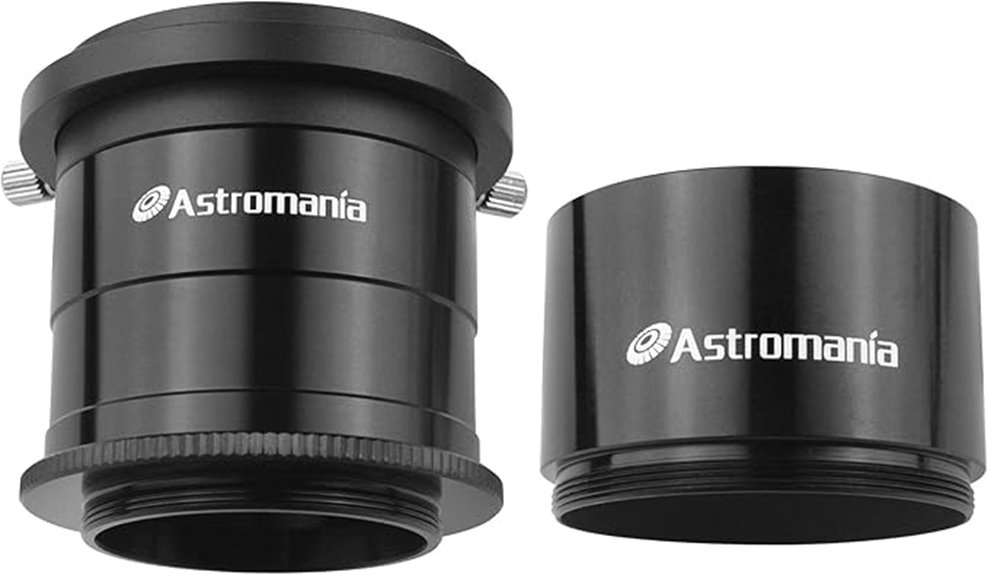
If you’re serious about capturing sharp, distortion-free images with your refractor telescope, the Astromania Field Flattener is an excellent choice. It guarantees perfect image flatness, reducing field curvature and producing pin-sharp stars across the entire image. Compatible with refractors from f/4 to f/8, it features M48 threading and 2 inches of back focus, accommodating various accessories. Made with high-quality lenses and multi-coatings, it enhances light transmission and minimizes aberrations. Weighing just 8.8 ounces, it’s lightweight and easy to attach. Ideal for both amateurs and professionals, it markedly improves the quality of your astrophotography.
Best For: amateur and professional astronomers seeking to achieve perfectly flat, sharp images in astrophotography with refractor telescopes from f/4 to f/8.
Pros:
- Ensures perfect image flatness and reduces field curvature for sharper star images across the entire field
- Compatible with a wide range of refractor telescopes using M48 threading and 2-inch back focus
- Constructed with high-quality lenses and multi-coatings to enhance light transmission and minimize aberrations
Cons:
- Price may be higher than basic field flatteners, potentially limiting budget-conscious users
- Compatibility limited to refractor telescopes within the specified f/4 to f/8 range; not suitable for other telescope types
- May require precise attachment and alignment for optimal results, which could be challenging for beginners
SVBONY SV550 Telescope (80mm F6 APO Triplet Refractor) Bundle
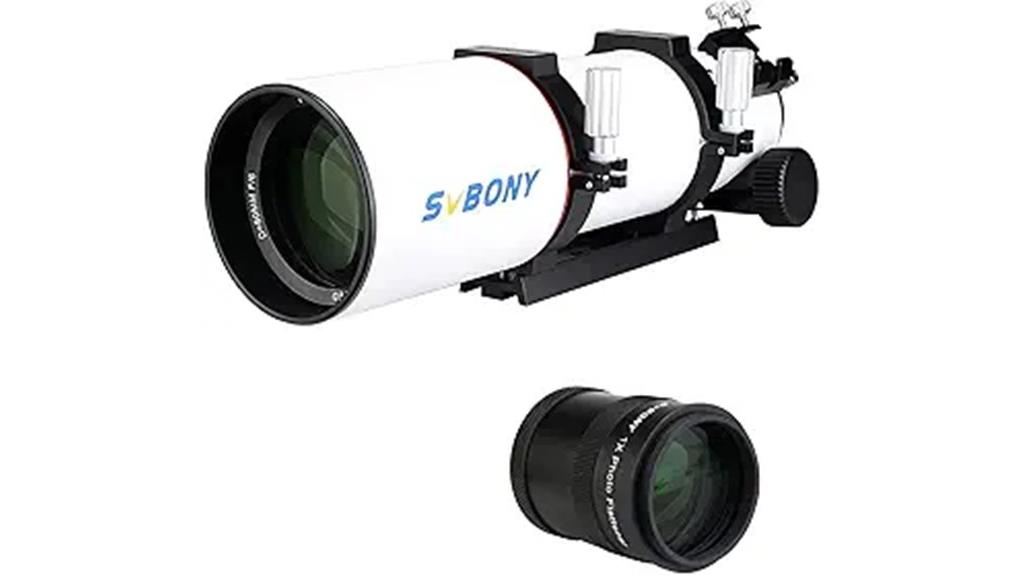
Photographers and astrophotographers seeking sharp, wide-field images will appreciate the SVBONY SV550 Telescope bundle, especially when paired with the SV209 field flattener. This 80mm F6 APO triplet refractor offers high-quality optics with minimal chromatic aberration and an expansive 45mm field of view, ideal for deep-sky imaging. Its internal light barriers reduce stray light, ensuring clear images. The magnesium alloy focusing system and hollow dovetail plate make it lightweight and portable, perfect for on-the-go astrophotography. With a standard 55mm back focal length, it works seamlessly with the flattener, delivering sharp, wide-field results for both beginners and seasoned astrophotographers alike.
Best For: astrophotographers and deep-sky imaging enthusiasts seeking high-quality, wide-field astrophotography with minimal aberrations.
Pros:
- High-quality APO triplet lens design minimizes chromatic aberration for sharp images
- Large 80mm aperture and 45mm field of view ideal for wide-field astrophotography
- Lightweight magnesium alloy focusing system and hollow dovetail plate enhance portability and ease of setup
Cons:
- Only compatible with flat field accessories like the SV209 flattener, limiting flexibility with other accessories
- Requires precise alignment and setup for optimal performance, which may be challenging for beginners
- Slightly heavier than some portable refractors, which could impact portability for some users
SVBONY SV193 Focal Reducer 2 Inch 0.8X Field Flattener
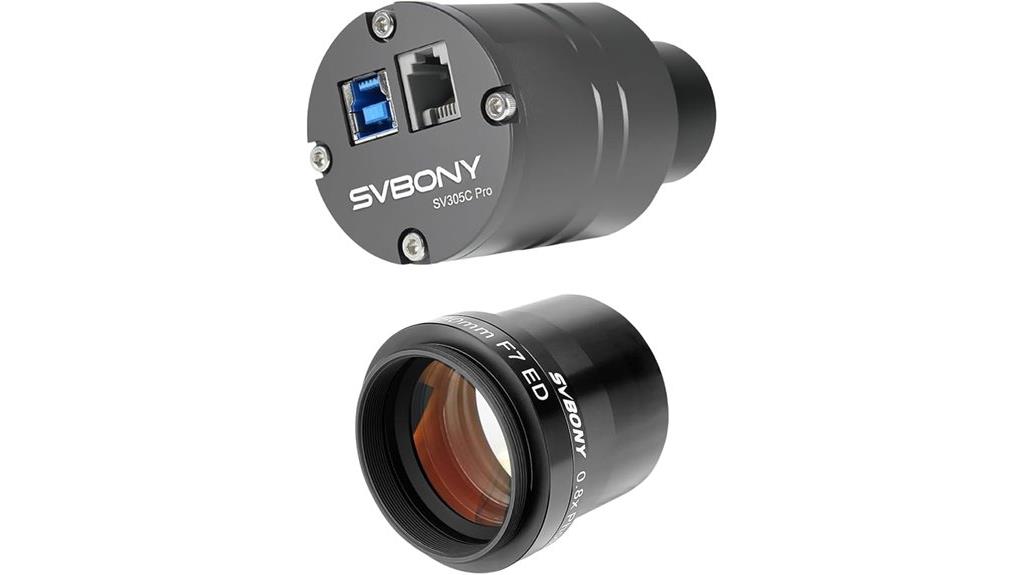
The SVBONY SV193 Focal Reducer 2 Inch 0.8X Field Flattener is an excellent choice for astrophotographers aiming to capture sharp, edge-to-edge images with their refractor telescopes. Designed for compatibility with telescopes like the SV503 80ED, it supports full-frame cameras and connects via a 2-inch front socket and M48x0.75 threaded back end. Its 0.8x focal reduction and field flattening capabilities ensure high-quality, distortion-free images of celestial objects. Whether imaging planets or deep-sky objects, this reducer minimizes star distortion, delivering clearer, more detailed astrophotos with consistent illumination across the entire field.
Best For: astrophotographers using refractor telescopes like the SV503 80ED seeking high-quality, distortion-free images of celestial objects with full-frame cameras.
Pros:
- Supports full-frame cameras for comprehensive astrophotography.
- Provides 0.8x focal reduction and field flattening for sharp, edge-to-edge images.
- Compatible with SV503 80ED and similar refractors, enhancing imaging versatility.
Cons:
- Price and stock may vary across platforms, potentially affecting accessibility.
- Requires precise attachment to compatible telescopes and cameras for optimal performance.
- May necessitate additional accessories or adjustments for best results in specific setups.
Factors to Consider When Choosing a Field Flattener for Refractor Telescopes
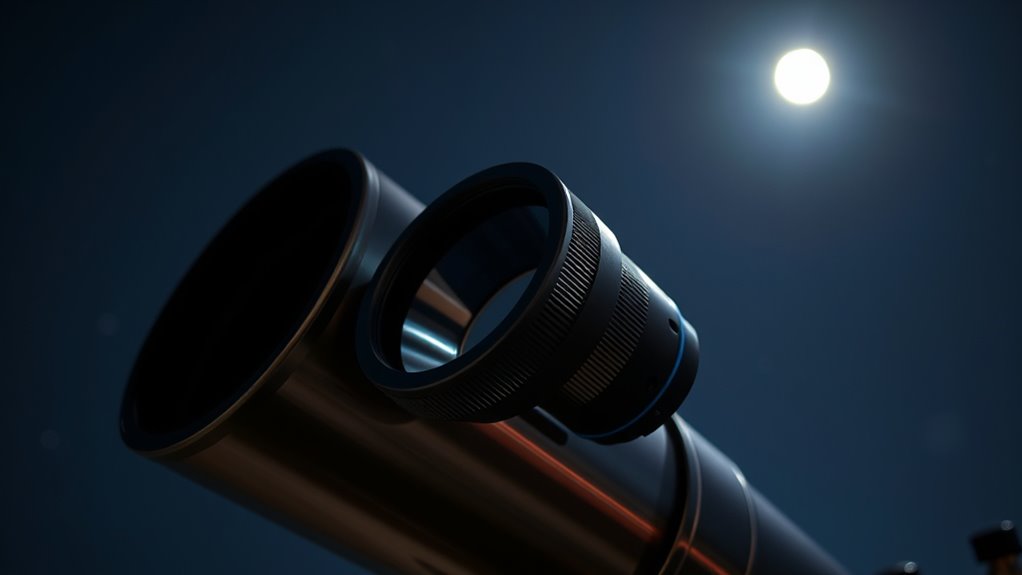
When choosing a field flattener, I focus on how well it matches my telescope’s focal ratio to guarantee ideal image quality. I also consider the quality of the optical coatings and how effectively it corrects field curvature. Additionally, I look at how easy it is to connect my camera and whether the build materials will last over time.
Compatibility With Focal Ratios
Choosing a field flattener that matches your refractor’s focal ratio is essential for achieving sharp, distortion-free images. If the flattener isn’t compatible, you risk increased aberrations or uneven correction across your image field. Most flatteners specify a recommended focal ratio range, usually between f/5 and f/7, which aligns with common astrophotography setups. Selecting one within this range guarantees proper correction and superior image quality. Additionally, the back focus distance often depends on your focal ratio, so verifying that the flattener supports your specific setup is critical to maintaining focus accuracy. Incompatibility can lead to subpar results, making it imperative to choose a flattener designed for your telescope’s focal ratio to achieve the best possible images.
Optical Coatings Quality
Optical coatings play a crucial role in ensuring high-quality images through a field flattener, as they directly affect light transmission and image clarity. High-quality coatings, like fully multi-coated or multi-layer options, increase light throughput and reduce reflections, resulting in brighter, sharper images. They also minimize surface glare and ghosting, which enhances contrast and maintains accurate color fidelity across the entire field. Superior coatings help reduce optical aberrations such as chromatic aberration and field curvature, leading to more pinpoint star images and improved astrophotography results. Additionally, durable coatings protect the lenses from scratches, environmental damage, and oxidation, ensuring long-term performance. Overall, investing in well-coated optics is essential for maximizing image quality and achieving consistent, high-grade astrophotographic results.
Flat-Field Correction Effectiveness
The effectiveness of flat-field correction hinges on how well a field flattener can eliminate field curvature, ensuring sharp, round stars across the entire image plane. High-quality flat-field correctors use multi-coated optics to minimize aberrations and provide consistent correction from center to edge. The degree of correction can be measured by how much star elongation or distortion reduces at the image edges; near-perfect correction results in negligible star shape deviations. Proper back focus and precise spacing between the flattener and camera sensor are essential, as misalignment can cause residual distortions. Ultimately, the success of flat-field correction is judged by uniform star shapes across the entire sensor, aiming for diffraction-limited sharpness from center to periphery, ensuring high-quality astrophotography results.
Camera Connection Ease
Selecting a field flattener that connects easily with your camera depends on understanding the compatibility of its connection interface and thread sizes. Make sure it has the right threads, like M48x0.75 or 2-inch sockets, for a secure fit. Confirm that the flattener supports your camera’s sensor size—full-frame or APS-C—to prevent vignetting or edge distortion. Checking the required back focus distance, usually around 55mm, ensures proper focus and sharp images. The connection should allow for straightforward attachment without needing complex adapters or extensions. Additionally, consider if the flattener offers integrated or compatible T-ring threads for seamless integration with your specific camera model. Ease of connection minimizes setup time and reduces potential alignment issues, making your imaging process smoother.
Build and Material Durability
Choosing a field flattener that’s built to last means paying close attention to the materials and construction quality. High-quality optical glass with multi-coatings ensures longevity and resistance to environmental factors, maintaining peak performance over time. The housing materials, like anodized aluminum or reinforced plastics, add sturdiness and protect against physical shocks and wear, especially during outdoor use. A well-made flattener maintains precise optical alignment even with temperature fluctuations, preventing image degradation and preserving star sharpness. Durability in materials also helps avoid optical distortions or warping that could compromise flat field correction. Robust construction supports consistent performance through frequent handling, transport, and long-term use, making it a reliable choice for serious astrophotographers who demand both precision and durability in their equipment.
Price and Value
When evaluating field flatteners for refractor telescopes, price and value go hand in hand. The cost varies widely depending on optical quality, compatibility, and brand reputation, affecting the overall investment. Higher-priced models typically offer better coatings, sturdier construction, and improved optical performance, making them a more reliable long-term choice. Comparing features like focal length compatibility and filter threading alongside price helps identify the best value for your specific astrophotography needs. Budget options may be cheaper upfront but often lack advanced coatings or precise manufacturing, which can compromise image quality or durability. By considering customer reviews and performance ratings, I guarantee that I get the most value for my money, balancing cost with quality to enhance my imaging results effectively.
Frequently Asked Questions
How Do I Install a Field Flattener on My Refractor Telescope?
To install a field flattener on my refractor telescope, I start by carefully attaching the flattener to the camera or eyepiece, depending on your setup. Then, I screw it into the telescope’s focuser or diagonal, making sure it’s snug but not overly tight. I double-check the focus and alignment, ensuring the flattener is properly seated. Finally, I test the setup through some star images to confirm sharpness across the field.
Can a Field Flattener Improve Images With Color Fringing?
Yes, a field flattener can help reduce color fringing in your images. I’ve found that it corrects optical distortions, including chromatic aberration, which often causes color fringing around stars and bright objects. When I use a good field flattener, my images look sharper and cleaner, with less unwanted color halos. It’s a simple upgrade that really enhances image quality, especially for astrophotography where detail matters.
Are Field Flatteners Compatible With All Refractor Telescope Brands?
Did you know that about 85% of amateur astronomers use compatible accessories? Field flatteners aren’t universally compatible with all refractor brands, but most are designed to work with popular models. I’ve found that checking the manufacturer’s specifications is key. While some flatteners are versatile, others are tailored for specific brands or models, so always verify compatibility before investing. This way, you guarantee ideal image quality and avoid frustration.
What Maintenance Is Required for a Field Flattener?
I regularly check my field flattener for dust, dirt, or any signs of damage, wiping it gently with a microfiber cloth. I also verify it’s properly aligned and securely attached before each session. Occasionally, I inspect the optical surfaces for scratches or smudges and use lens cleaning solutions if needed. Keeping it clean and well-maintained guarantees peak performance and sharp, flat images during my astronomical observations.
How Do I Choose the Right Focal Length for My Astrophotography Setup?
When choosing the right focal length for my astrophotography setup, I consider the type of targets I want to capture. Longer focal lengths give me more magnification, ideal for planets and small objects, but can make framing tricky. Shorter focal lengths are better for wide-field shots like nebulae and star fields. I also balance focal length with my camera’s sensor size and tracking capabilities to get sharp, detailed images.
Conclusion
Choosing the right field flattener is like finding the perfect lens to bring your universe into sharper focus. With so many options available, you’ll want to pick one that fits your telescope and imaging style. Remember, a good flattener isn’t just an accessory—it’s the magic wand that transforms your starry dreams into stunning reality. So, gear up and let your astrophotography shine brighter than ever before!

